Koper’s [Public] Optimism
Text by Bostjan Bugaric
José Saramago created an apocalyptic vision in a city hit by an epidemic of white blindness that spares absolutely no one. His novel Blindness tells the tale of a plague and at the same time evokes trembling horrors of the 20th century when an encounter becomes literally as frightening as we are experiencing today. How will we live together when public places are shut down and the only public communication takes place online? The whole story transformed reality by the fear of the unknown. Is it a war, an isolation or just the fear of living too close to each other? The open doubt if they have been blind ever since, “blind people who, even though they see, do not see”, leads them to question whether it is essential to know why they are blinded or how to find ways to overcome it.
(Publicness) Lost in Transition in the Three Cities’ Landscapes
Every time around New Year’s Eve an illusion of hope doesn’t spare the historic city centre of Koper, which is being enlightened with Christmas lights worth more than half a million Euros. The only visible life in the city at this time of the year is actually sparkling for just a few months, under the impressive burden of a glittering plastic mask and kitschy lights. For the organizer, the municipality of Koper, these lights become a problem for the rest of the year as they don’t have a storage space. In the city of so many empty buildings, owned by the municipality itself, this opens the question of the management of the public money, public space and the city in general, which is mostly missing its specific content. Wouldn’t it be more rational to use the empty spaces and buildings for temporary use instead of leaving them to decay just under everyone’s gaze? However, when New Year’s glare fades out, emptiness hovers on the city, embracing the empty streets. Nevertheless, the city is hiding three important historical landscapes that provided it with its final structure; landscape of the Venetian Gothic, the Socialist City and the Neoliberal City of Consumption. Each one was created by the governance of the ownership and division of capital in a specific period of time, but the biggest changes in the urban structure have happened during the last three decades.
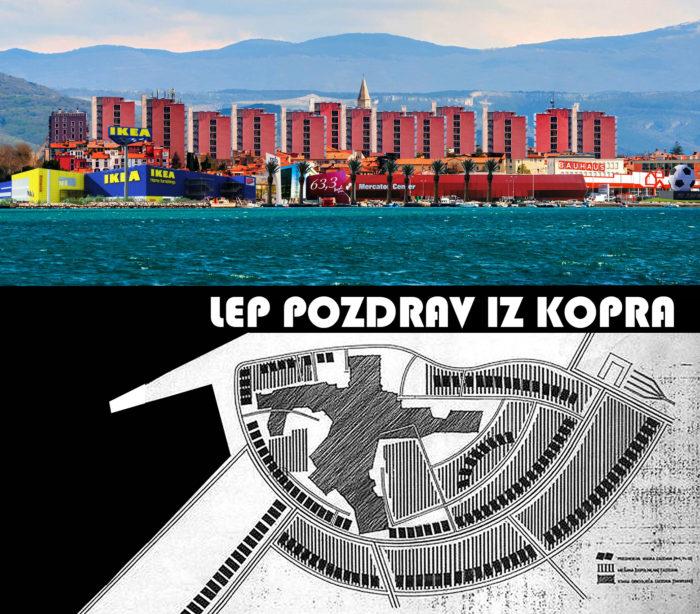
The first layer started already at the time of the Venetian Republic “La Serenissima”, when the city on the island developed into an important political and administrative centre. The name Capo d’Istria, the head of Istria, describes its power as the capital of the Istrian peninsula. The design of the city was defined by the convex shape of the island where palaces, churches, prisons, and larger complexes were located in the central part due to the solid ground to build on whereas small buildings, mostly fishermen houses, were located around the edge of the city centre, just next to the latter’s walls. The construction of the city took more than half of a century. After over 500 years of uninterrupted rule, the Venetian Republic came to an end in 1797 and the territory went under the Habsburg Empire, then under the French rule in 1805-1813, and finally under Habsburg Austria for a good 100 years. After heading Istria for a long time in both economic and cultural terms, Koper lost its leading role in the 18th century, and with the accession to the Habsburg monarchy gained the character of a province. The administrative, economic and cultural centre was then transferred to Trieste.
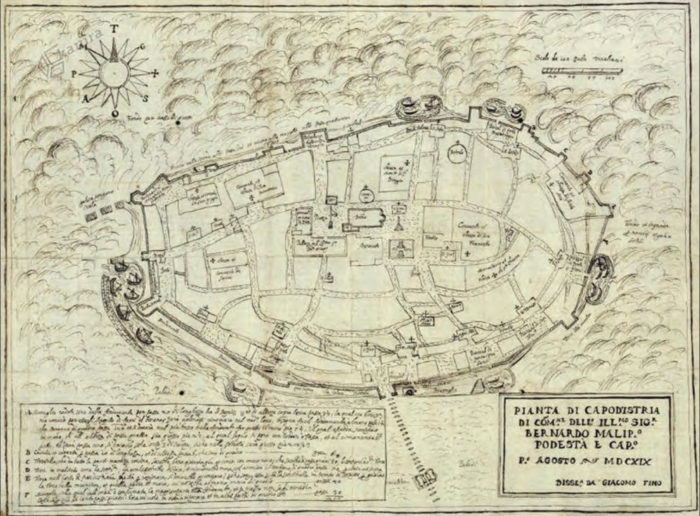

A major transformation of both the social and urban structure occurred during the Yugoslav period, when the Communist regime replaced most Italian bourgeois intelligence dwellers from the city centre with the working-class, imported from the former Yugoslav republics to become the new workforce for the Port of Koper, founded in 1957 as well as the Tomos Factory[1], founded in 1954. The idea of new housing for workers was proposed in the 1960s by architect Edo Mihevc. He developed a new urban paradigm for the needs of the working class in the form of residential high-rise skyscrapers laid out around the perimeter of the former island. This new urban concept was meant to interfere both functionally and ideologically with the formerly dominant vertical element, the bell tower of the church. The skyscraper, a Socialist symbol of the new working-class structure, is considered a case in point of the urban modernization of Koper historical centre. The ideologically conditioned plan of building new city walls consisting of skyscrapers was never fully implemented. However, the needs of cultural venues for the new social structure didn’t develop according to the original plans of Mihevc, who instead envisaged the creation of public spaces, meaningfully designed to increase the diversity of social content.
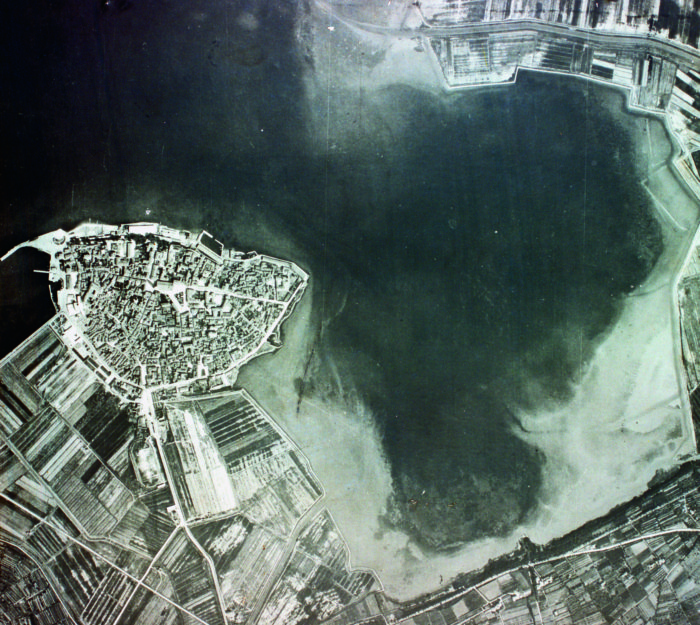
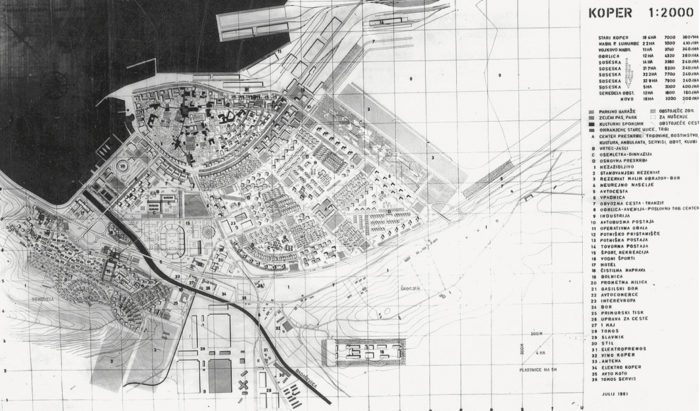

After Mihevc’ general plan for the urban development of the city, the renovation of cultural monuments, design of public spaces, and green areas took shape as a combination of public-private partnership during the period of independent Slovenia in the 1990s. Submission of ownership, change of land purpose and mismatch of interested investors left both location and buildings decaying rather than reusing or renovating them. An example of this process is the monastery belonging to the “Servi di Maria”, a complex in the historical city of nearly 3000sqm abandoned since 1996. Incapability of negotiation by its owners, the Ministry of Culture, caused and accelerated its decay. In the hands of the political clientelism, with the mandate of the last mayor Boris Popović lasting for 16 years, from 2003 to 2019, relevant projects were developed according to the preferences of current political decisions, despite the proposals of urban competitions[2], urban studies or expertise and requirements of The Institute for the Protection of the Cultural Heritage[3]. The mayor Popović changed the impact area around the historical centre in 2007, so the pressure of private investors created an urban plan for the construction of a new city of consumption in the southern portion of the settlement, next to the historical city centre. The public space right from the main entrance at the Port of Koper to the Bonifika sport area on the other side of the city was sold to companies like Merkator, Lidl, Hofer, Interspar, Harvey Norman, Eurospin, Tuš, McDonalds, Obi and many others. The process of wild capitalist planning didn’t even take into consideration the natural area of Škocjan refuge on the border with the new city of consumption, separated only by the newly constructed main road in-between them. However, the period between 2007 and 2013 can be marked as the first wave of commercialization of the city’s public land while the leftovers were to be bargained with the commercial housing companies which built residential housing in the middle of shopping malls, parking areas and gasoline stations. Shopping areas in Koper were keeping up with the development of the rest of Slovenia and were constructed in a very short time and without any development plan. The public land was exchanged with private parking for the shopping malls in the newly constructed city of consumption.
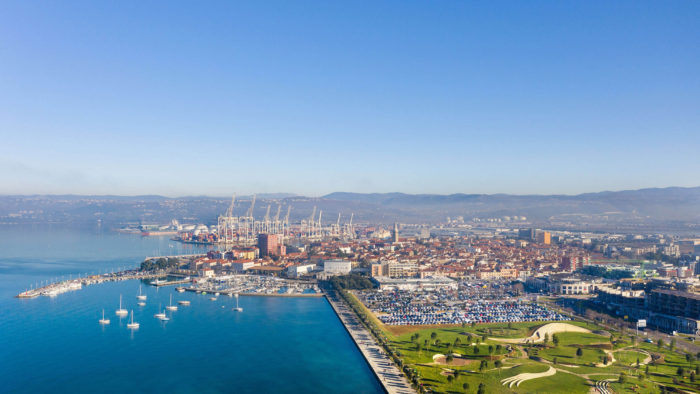
Koper’s Public Landscaping
After the 2008 crisis in constructions and real estate a huge amount of unfinished building sites accumulated also in Koper, the most evident of which is the Solis complex located next to the historical city centre. Its construction started in 2008 as a combination of public-private partnerships with unrelated interconnecting facilities such as the municipal administration, hotel with saunas, commercial shopping areas and the Olympic swimming pool. The construction was stopped for more than ten years also because Primorje, one of the largest Slovenian building firms, couldn’t bring the work to an end due to f its collapse and bankruptcy. The building was left unfinished for over a decade becoming a ruin hiding the historical city centre. However, there were no open discussions or critiques regarding the then current situation also because of the missing participation of architects to both the debate and all decisions on how to use public resources left to the investors. All this marked the beginning of investor urbanism in Koper.
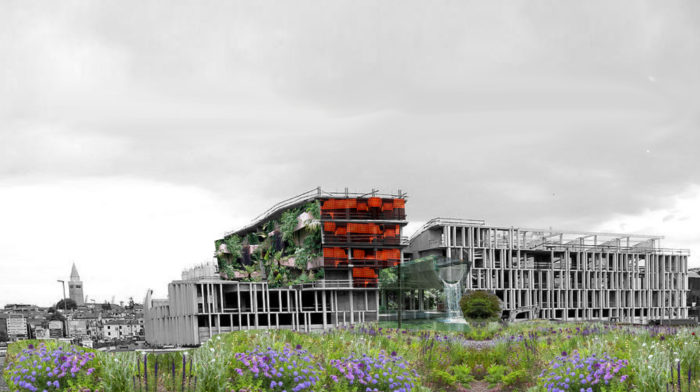
As a counterpoint during the study process, the University of Primorska started an experiment with students in order to extend the debate on Koper urban issues to the general public, tackling different ways of communicating architecture. A documentary film on the consequences of investor urbanism was publicly showed for the first time although censored[4] by the head of the municipal administration. Notwithstanding the ban the documentary was screened on the University façade in order to present the idea that the city shall not accept the failed investments for granted because there is no other opportunity opened from the local stakeholders, a kind of implosive view on the matter of development.
The Fall of Public Space and Tree City Houses
Half of the city is a race to the capital whereas the other encourages participation. Which one is permanent and which is temporary? In the old city centre of Koper, the role and number of public spaces varied markedly during different historical periods but they have been crucially shrunk due to Neoliberal money making facilities. The last comprehensive urban plan for Koper was prepared in the 1960s by Mihevc and a remnant of that plan, the workers’ skyscraper, has been sold to a private investor by current policy. The impact area around the city centre was transformed into the city of consumption where the shopping areas surprisingly share a parking lot with prisons built under the 1980s partial redevelopment plan. What happens in a certain period of time, while capital took a development of the city without an urban plan, where social and public buildings are sold or demolished, in other words left to the investor urbanism, can be understood from three buildings from different periods located in different parts of the city of Koper.
The Prison
In 1954 the Communist government nationalized the monastery of St. Ana on the fringes of the historical centre and placed the main city prison in the monastery. However, there were already plans prepared in the 1980s to build a new prison on the marsh area next to the natural reserve. Following Slovenia’s independence, when it was clear that the former monastery will be returned to the Franciscans with the 1997 denationalisation, the plan was to finally complete said prison according to the 1984 redevelopment plan. By 2004 detainees were moved in. After the dissolved impact area in 2007 the rapid sealing of the area with commercial shopping malls occurred. Today this is evident in the shared parking area between the prison and the adjacent shopping mall, a failed programmatic combination deriving from the recurrent lack of a general plan for the city of Koper. Had there been a plan and an expert with common sense, it would have been really difficult to reach a situation like the present one, where the only development criteria are the money investments.

The School
The primary school Pinko Tomažič was designed by Edo Mihevc in 1960. The building is a prominent example of typical Slovenian Modernism characterized by a peculiar relationship between opaqueness, transparency and a green space. The orthogonal mass is raised above the ground, thereby creating two atriums and an overall transparency at the ground floor. In 2005 the school was demolished by order of the mayor Popović and a larger school was built in its place, with the facade facing the city acting as a screen onto which political slogans could be displayed[5]. In recent times public buildings as devices to convey political ideology were typical of Italian Rationalism, a clear example being Giuseppe Terragni’s Casa del Fascio in Como, where the right part of the main façade was intended for displaying political ideology, manifestos and flags. Only after 16 years, following the election of the city’s new mayor, the inscription has been removed.
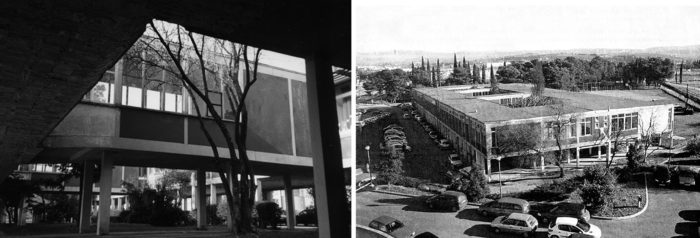

Another modernist public building that has fallen under the pressure of the capital is the Janko Premrl Vojko primary school, located in the historical centre of Koper. An architectural competition for its renovation was carried out in 2006 but it was never really meant to be realized. The school was in fact to be replaced by a Museum Square and an underground garage for a new skyscraper to be designed and sold under private entrepreneurship, moreover the ex-mayor already authorized the laying of the new premises foundations so it is quite hard to understand the reason why the competition was ever launched.
The Skyscraper
Located in the historical centre of Koper and built in 1957, Tomos Skyscraper stands on the site of the former Gregorite Monastery and is the most recognizable building in Koper’s Belvedere complex. Both the latter and the skyscraper have been designed by Edo Mihevc who envisioned and shaped most of the Slovenian coast[6]. The architect carefully planned all the interventions both in the coastal landscape as well as in its cities, adopting the regional characteristics and interpreting them in a very personal way, developing a methodology for creating a new spatial typology for the area. Each coastal town was given its specific function: Koper as a port city with industry, Ankaran as a resort, Izola as a fishing town with associated industry, Piran as a historic city, and Portorož as a fashionable tourist centre surrounded by tourist resorts[7].
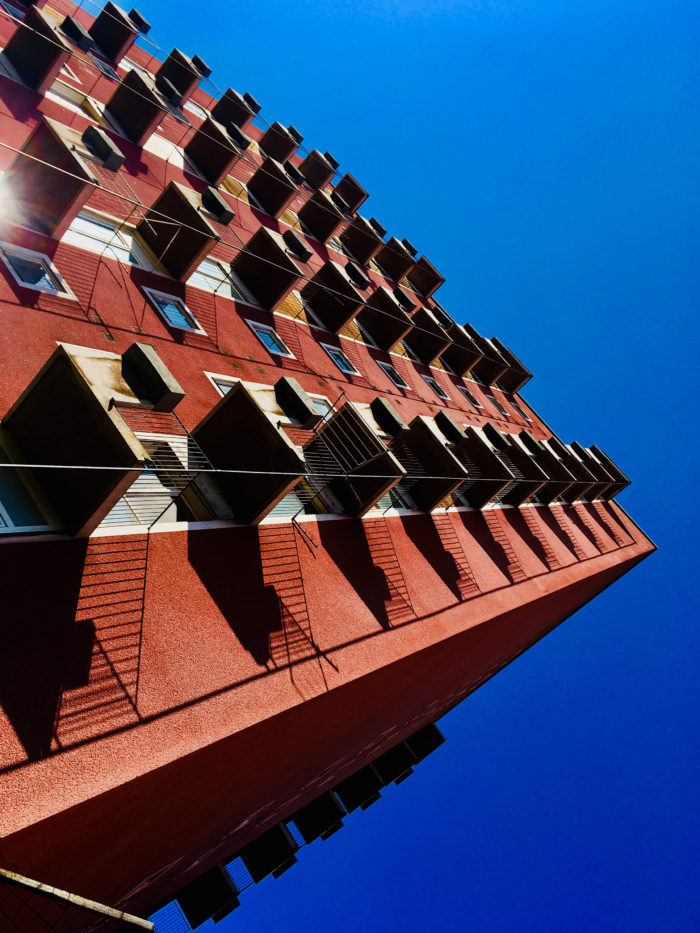
Despite protecting local identity, Mihevc envisaged a demolition of a huge part of the historical city centre of Koper to erect several modernist skyscrapers. The urban project was stopped due to public opposition; only two towers out of the envisaged set of buildings surrounding the city walls saw completion. The solitary skyscraper was designed as a home for Tomos factory workers and consists of two different parts, a public basement onto which rises a 10-story residential monolith. The building structure is in reinforced concrete, enabling the random organization of floor plans.
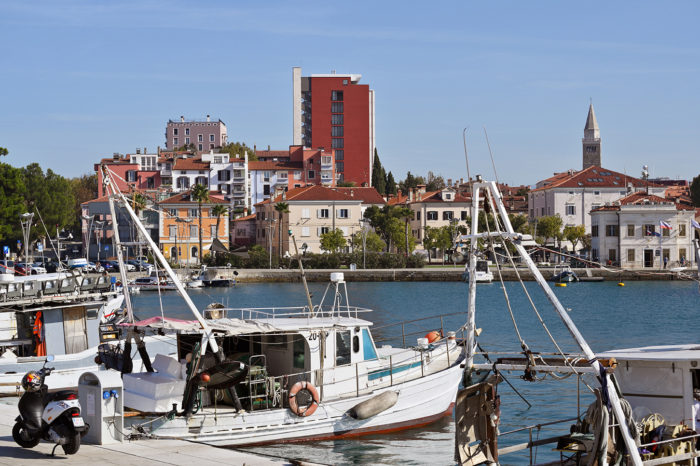
This proved beneficial in 2018, when the private investor who bought the skyscraper decided to not demolish the building but renovate it instead. Beside the common areas on the ground floor there were 90 small flats, each laid out to be inhabited by two workers. Over time the social structure of the population of the building has changed, with families moving into small flats and leaving the building insufficiently maintained throughout the years becoming dangerous for its inhabitants. In 2007 the municipality owning the building moved the residents out. The original plan was obviously too pretentious to realize the winning entry of the 2006 competition. Notwithstanding different proposals of temporary use based on research studies and being the Koper municipality incapable to let the expert take a decision, during the in-between period the building was left to decay until 2018.
Temporary use is becoming a common strategy of re-urbanization, with brownfield areas or buildings in decay given a time-limited use in order to preserve their architectural structure prior to their final refurbishment, but to the urban policymakers in Koper this seems not yet acceptable and not completely clear. Although similar cases can be found all over Europe like the Haus der Statistic in Berlin, HausHalten in Leipzig, Hallo Festspiele in Hamburg (Germany), LX Factory, Fabrica Braco de Prata, Trafaria Platform in Lisbon (Portugal), Architectural Prison Summer School in Kotor (Montenegro), The Tobacco Factory in Gijon (Spain), The Port Warehouse in Caen (France), See U Project Laboratory, Studio CityGate and Recyclart in Bruxelles (Belgium) and OGR Officine Grandi Riparazioni or Hangar Bicocca in Milan (Italy) in Koper this seems to be inapplicable.
Touristification Of Public Space via Investor Urbanism
Lacking urban expertise or consultancies providing them with effective alternative options, the Koper administrators seem to be convinced that the only possible developmental plan for the city is the one addressing tourism and investing in it. But there are no tourists in the city and that’s also because it lacks relevant attractions as well as a real development concept. After more than 20 years of observation, research and reactivation in Koper it is difficult to claim an approach which can bring back the programmatic diversity into the city. In my PhD research I worked on a study on how a strategic implementation of the university program in Koper could implement a model of city university, which the city could benefit from, instead of dislocating the city campus. The university program could serve as a main generator in the process of the revitalization of abandoned and empty buildings in Koper. This experimental approach was based on the temporary program implemented in abandoned spaces and buildings on the Kidričeva Street, e.g., the student house in Tomos Skyscraper, faculties in Toto ex-Gavardo, Post office building, Armeria and a library in abandoned monastery. In such a way the main university (Tito’s) square with the rectorate and Faculty of Humanities connects the city promenade and creates a vivid pedestrian university street. With this renovation,the university street being the main spine of the concept, the application of temporary content becomes the generator towards urbanity.
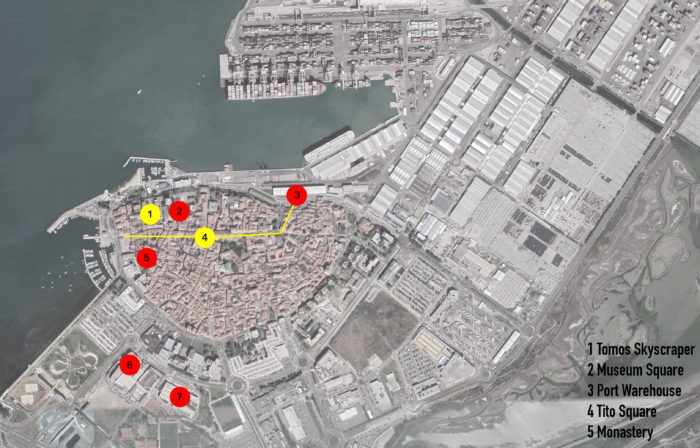
But…what happens when the university takes on the role of mediator between politics and urban development? Placing a university programme in the decaying urban tissue is for sure an elaborate strategy for social and physical renewal but when academic premises become the main priority of the developmental program, tourism doesn’t help much for the development of urbanity. The University of Primorska had never had an overall development plan based on a structured expansion of the city and its dwellers. Instead, together with city politics, enabled partial regulation, with no vision and no long-term plan based on contemporary strategies of urban design[8]. The local administrative policy needs help to design an urban plan as it doesn’t invite experts that would solve the issues at stake. Instead mistakes repeatedly made in the past under similar impulses are taking over all available space and are visible in the selling of both public areas and buildings. In spite of the plan, the island was never covered by a necklace of working-class residential skyscrapers but today, without a plan, it becomes overtaken and covered by the new wall of consumerism.
Emerging Knowledge of Open Sourcing Library
Once there was a land called Yugoslavia, a place where both architecture and infrastructure were born from a need of creating better living conditions in solidarity and collaboration among its citizens. Here factories were able to organize the cooperative systems of production which was based on self-management, and cooperatives were offering workers their own production of publicness, creating awareness, developing common projects including housing for both white and blue collars, like the ones the Koper Tomos skyscraper was designed for.
The exhibition at the Museum of Modern Art in New York, ‘Toward a Concrete Utopia: Architecture in Yugoslavia, 1948–1980’ has been an international turning point in the appreciation of Yugoslavian architectural heritage since it showed how innovative and powerful the language of Modern architecture has been. Vladimir Kulić, co-curator of the show with Martino Stierli, explained how the exhibition »demonstrates that innovative, interesting architecture existed also in what used to be the former Socialist world. Yugoslavia is a great example that tells that the story is much more complicated. Architecture in the US has been largely reserved only for the super wealthy. Kulič explains that »the amount of architectural thinking that at one point used to be much more widely distributed among the population is now concentrated in the hands of one percent of the population. Yugoslavia in that sense is a kind of a reminder that architecture had wider social responsibility in transforming society and working for people beyond the wealthiest.« Teams of professionals from those different countries which once formed Yugoslavia made a huge effort in the research process, saving the forgotten archives, digitizing, rescuing the existing material and bringing its values to the forefront of the common knowledge. In Koper people don’t appreciate and evaluate such architecture.
In today’s world of limited natural resources there are new ways of communication and creating networks that can gather bottom up initiatives, shattered small farmers, precarious cultural workers and forgotten cooperatives in the fight of the new solidarity within the right to the city. The main power in today’s exhausted territory is the use of correct educational and communication skills. In the raped urban landscape of Koper there is only one way to empower the commons by creating diversity and gaining independence. If politics work hand in hand with investor urbanism, which is completely the opposite of the one planned in the 1960s, how can today’s real problems be solved? If commons/dwellers are convinced that the potential of urban public spaces are circumvented by politics and, consequently, by the profession, then design, management and maintenance of public spaces is becoming a completely marginal topic, missing both clear visions and a strategic approach.
How can we live together?
Enough of negative scenarios from the past, we as intellectuals and space experts need to take over the meaningless decisionmakers destroying our identity in our cities. There is still enough room for optimism in Koper.
The first part of the strategy lies in the production of public spaces with elaborated contents bringing together different commons and creating a safe space for meetings and knowledge sharing. Instead of building new concrete structures, the strategy implements reuse and temporary use of empty spaces and houses in the city of Koper. After water, concrete is the most widely used substance on the planet. If the cement industry were a country, it would be the third largest carbon dioxide emitter in the world with up to 2.8bn tonnes, surpassed only by China and the US. Concrete is to be responsible for 4-8% of the world’s CO2. The last 30 years the city of Koper saw too many unfinished, misused and completed concrete buildings. The refurbishment vs. new building ratio is low and a case in the former category is the Tomos solitary skyscraper. A debate with the investor opened up the possibility of locating and organizing there the first temporary space of solidarity named Avtomatik Workspace, a safe space aimed at presenting different communities and stakeholders with a different way of communicating architecture.
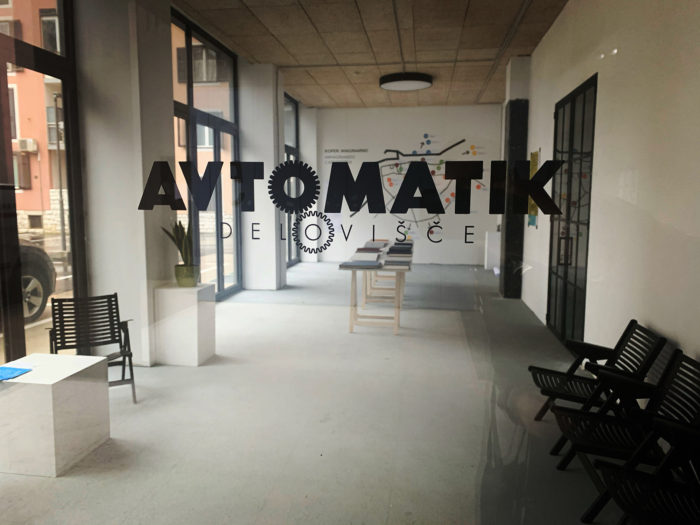
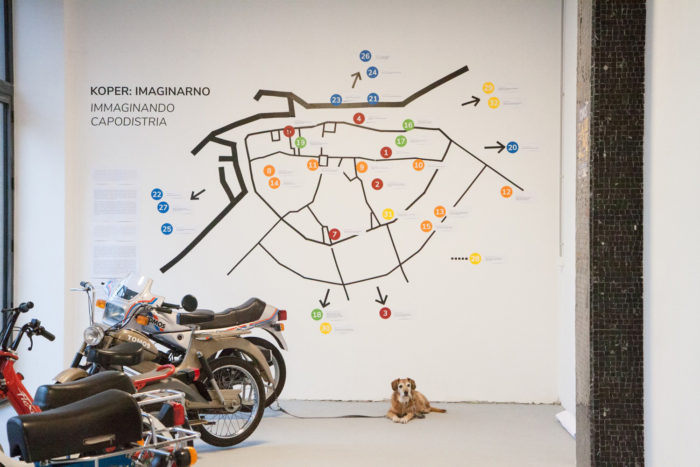
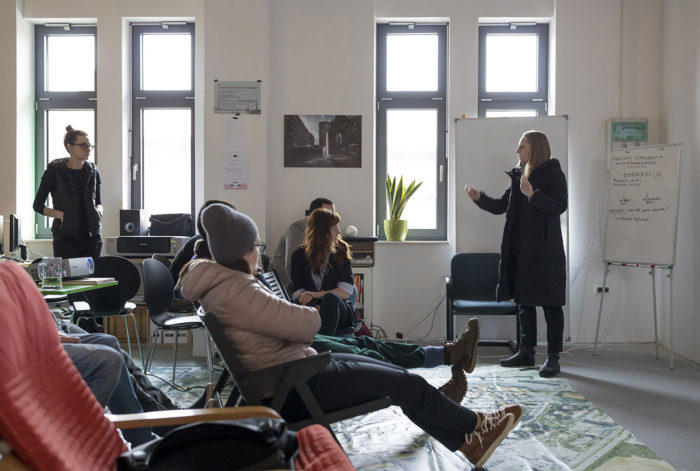
Creating open source online archives compounded with written and oral research are forming a library of oral history, collecting the knowledge from the past and creating a story for the future. Such a movement is but a first step towards building the new city walls, including different narratives from the city itself. Let’s stop erecting new unnecessary buildings and start building contents instead, everything is already there, all it really needs is only starting to be collected.
[1] Tomos was a moped manufacturer based in Koper. Tomos acquired a production license from Puch to produce moped models under the Tomos name in 1954. Tomos had since produced various goods for the Eastern European market, including motorcycles, mopeds and Citroën cars for the home market. Tomos mopeds were also produced in Epe, Netherlands since 1966. Tomos mopeds were sold in the U.S. from 1976 to 2014. Tomos went bankrupt on January 3rd, 2019.
[2] In 2006, a public competition was launched for five locations of public areas and squares in Koper. Despite the expert’s commission selected, the interests of politics and capital prevail and instead of the first-prize winner plan a completely different, mostly commercial program is envisaged.
[3] The Institute for the Protection of Cultural Heritage has elaborated only strategies for the protection of the period before the First World War; however, there are no proper protection strategies for the Modernist heritage.
[4] The director of the city municipality administration in Koper invited authors of the documentary for a meeting on 25.05.2017, on the day of the venue, where was stated that the story of Solis can’t be publicly presented in the media, while the movie about the temporary use of the Solis complex prepared by students and authors can’t be publicly presented if not review by the three members of the municipality.
[5] The inscription 63.3 thanks on the facade of the new elementary school in Koper represents the percentage that Mayor Boris Popović received in the referendum for the construction of this school – a political manifesto on a public facility.
[6] Mihevc’s activity on the coast is certainly not only the result of much political support, but also the fact that at that time there were few designers who could manage such a demanding task. Ravnikar dealt with this before Mihevc, but was quickly removed from the project by the authorities, appointed Mihevc as the planner of the Coast and demanded that Ravnikar submit all documentation to Mihevc. (Teržan, 2011)
[7] Teržan, 2011
[8] No need to mention that even today the municipalty appointed a team of experts for the revitalization of 3000sqm monastery of Serviti without including neither active architects nor urban designers in the team, an ongoing situation since 1996.
[9] Automatic Delovišče is creative community, a virtual space that encourages integration, cooperation and connection in the city. It is also a temporary physical space, meeting point for creatives from different fields, interested public and local policymakers. The online platform of collecting knowledge and an open source library is available via Zbirnik
Dr. Boštjan Bugarič is an architect, researcher, curator, critic and editor. Since 2014 is an editor at the open source community Architectuul in Berlin. He also leads KUD C3, a collective for spatial research of contemporary urban trends. In 2011 he was awarded with the Golden Cube Award for the project Public city. As an artist in residence by the Ministry of Culture of Republic in Slovenia was in London (2016) and in New York (2012). In 2014 he collaborated at a community recuperation project in Mexico City within Casa Imelda and UAM University. For the University of Primorska in Koper he coordinated the accreditation and established the Faculty of Built Environment (2008-13), where he took a position of the acting dean (2011 – 2013). In same period was active as a president of the Society of Coastal Architects Koper, Slovenia. In 2012 he leaded an independent reestablishment of the Slovenian Cultural Center in Vienna. In 2017 was invited to be a visiting critic at Cornell University Rome. The same year was a research collaborator at Faculty of Architecture Ljubljana. He is a professor at the Visual art and Design department at the Faculty of Pedagogy in Koper and at the Academy of Fine Arts and Design in Ljubljana. He collaborated at numerous lectures in Slovenia and abroad and exhibited as a selected author at U3 Triennale of Contemporary Art in Slovenia in MSUM+ Ljubljana in 2013, as a selected lecturer for the international workshop Wonderland Berlin – Funding Urbanism at DAZ Berlin in 2014. Same year he was leading Architectuul’s international project Unfinished,organized in Slovenia, Czech Republic, Slovakia, Serbia, Macedonia, Bosnia and Herzegovina, Kosovo, Montenegro, Austria, Albania and at the final event at the Serbian pavilion of the XIV Architecture Biennial in Venice. Since 2016 he is coordinating the Architcetuul’s associated partnership at the Future Architecture Platform.